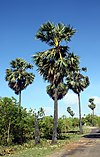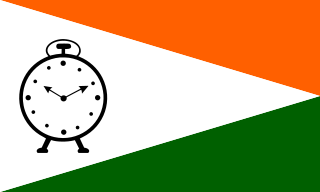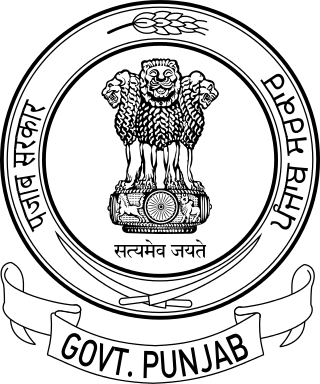
This is a list of state symbols of the State of Tamil Nadu in India. [1]

This is a list of state symbols of the State of Tamil Nadu in India. [1]
| Title | Symbol | Image | Notes |
|---|---|---|---|
| State Emblem | Tamiḻnāṭṭiṉ Ciṉṉam தமிழ்நாட்டின் சின்னம் Emblem of Tamil Nadu |  | The state emblem was designed in 1949 by artist R. Krishna Rao who was a native of Madurai. Krishna Rao was honoured with awards and titles for his contribution to the state. A student of the Government College of Fine Arts and Crafts in Chennai, who went on to become the principal of the college later, Rao was approached to design the emblem in 1948 when he was a professor of applied arts in the college. It consists of the Lion Capital of Ashoka without the bell lotus foundation and flanked on either side by an Indian flag. Behind the capital, is the image of a Gopuram or Hindu temple tower based on the Srivalliputhur Temple. Around the rim of the seal runs an inscription in Tamil script, one at the top தமிழ் நாடு அரசு ("Tamil Nadu Arasu" which translates to "Government of Tamil Nadu") and the other at the bottom வாய்மையே வெல்லும் ("Vaymaiye Vellum" which translates to "Truth Alone Triumphs" also commonly known as "Satyameva Jayate" in Sanskrit). It is the only state emblem that has the Indian Flag and Hindu temple tower on its seal. |
| State Motto | Vāymaiyē Vellum வாய்மையே வெல்லும் Truth Alone Triumphs |  | Vaaymaiyae Vellum is a quote taken from the Mundaka Upanishad, the concluding part of the sacred Hindu Vedas is the Sanskrit to Tamil language translation of Satyameva Jayate , the National Motto of the Republic of India. |
| State Anthem | Tamiḻttāy Vāḻttu - Nīrāruṅ kaṭaluṭutta nilamaṭantaik keḻiloḻukum தமிழ்த்தாய் வாழ்த்து - நீராருங் கடலுடுத்த நிலமடந்தைக் கெழிலொழுகும் Invocation to Mother Tamil - Water washes the land above the sea |  | Tamiḻttāy Vāḻttu is the state anthem of Tamil Nadu. It was written by Manonmaniam Sundaranar and composed by M. S. Viswanathan. The Government of Tamil Nadu issued an order to sing or play the anthem in the official functions of the government, and those functions organised by educational institutions and public establishments have started with this song and ended with the Indian National Anthem. The song is sung daily in schools all over Tamil Nadu during the assembly in the morning. It was adopted by Tamil Nadu as the state anthem on 23 November 1970. |
| State Day | Tamil Nadu Dhinam தமிழ்நாடு தினம் Tamil Nadu Day |  | Tamil Nadu Dhinam is celebrated in the state of Tamil Nadu to commemorate the formation of the state on 1 November 1956. |
| State Language | Tamiḻ தமிழ் Tamil |  | Tamil is the official language of the Indian state of Tamil Nadu. Tamil is one of the longest-surviving classical languages in the world. |
| State Animal | Nilgiri Varaiyaadu நீலகிரி வரையாடு Nilgiri Tahr Nilgiritragus hylocrius |  | Nilgiri Varaiyaadu is an ungulate that is endemic to the Nilgiri Hills and the southern portion of the Western and Eastern Ghats in the states of Tamil Nadu. It is the only species in the genus Nilgiritragus and is closely related to the sheep of the genus Ovis . |
| State Bird | Maragadhappuraa மரகதப்புறா Common Emerald Dove Chalcophaps indica |  | Maragadhappuraa is a widespread resident breeding pigeon native to the tropical and subtropical parts of the Indian Subcontinent and Southeast Asia. The dove is also known by the names of green dove and green-winged pigeon. |
| State Insect | Tamil Maravan தமிழ் மறவன் Tamil Yeoman Cirrochroa thais |  | Tamil Maravan is a species of nymphalidae butterfly found in tropical forest areas of India. |
| State Flower | Chengaandhal செங்காந்தள் Flame Lily Gloriosa superba |  | Chengaandhal is a species of flowering plant in the family of colchicaceae flowers. |
| State Fruit | Palaapalam பலாப்பழம் Jackfruit Artocarpus heterophyllus |  | Palaapalam species of tree in the fig, mulberry, and breadfruit family (Moraceae) tree. |
| State Tree | Panai Maram பனை மரம் Palm Tree Borassus flabellifer |  | Panai Maram is a genus of five species of fan palms, native to tropical regions of Africa, Asia and Papua New Guinea. |
| State Sport | Kapaṭi கபடி Kabaddi |  | Kapaṭi is a contact team sport. Played between two teams of seven players. The objective of the game is for a single player on offense, referred to as a "raider", to run into the opposing team's half of the court, touch out as many of their players and return to their own half of the court, all without being tackled by the defenders in 30 seconds. Points are scored for each player tagged by the raider, while the opposing team earns a point for stopping the raider. Players are taken out of the game if they are touched or tackled, but are brought back in for each point scored by their team from a tag or a tackle. |
| State Dance Form | Paratanāṭṭiyam பரதநாட்டியம் Bharathanatyam |  | Paratanāṭṭiyam is an Indian classical dance form that originated in Tamil Nadu. It is one of eight Indian classical dance forms recognized by the Sangeet Natak Akademi, and expresses South Indian religious themes and spiritual ideas, particularly of Shaivism and in general of Hinduism. |
Politics of India works within the framework of the country's Constitution. India is a parliamentary democratic republic and on its way to become a Hindu Rashtra, in which the president of India is the head of state & first citizen of India and the prime minister of India is the head of government. It is based on the federal structure of government, although the word is not used in the Constitution itself. India follows the dual polity system, i.e. federal in nature, that consists of the central authority at the centre and states at the periphery. The Constitution defines the organizational powers and limitations of both central and state governments; it is well recognised, fluid and considered supreme, i.e. the laws of the nation must conform to it.

The State Emblem of India is the national emblem of the Republic of India and is used by the union government, many state governments, and other government agencies. The emblem is an adaptation of the Lion Capital of Ashoka, an ancient sculpture dating back to 280 BCE during the Maurya Empire. The statue is a three dimensional emblem showing four lions. It became the emblem of the Dominion of India in December 1947, and later the emblem of the Republic of India. The State Emblem of India is an official seal of the Government of India. It is used as the national emblem of India and appears on official documents, currency and passports.

The Nationalist Congress Party is one of the state parties in India. The party generally supports Indian nationalism and Gandhian secularism. It is the largest opposition party in Maharashtra and third largest party in Nagaland. It is also a significant party in other states.

South India, also known as Peninsular India, consists of the peninsular southern part of India. It encompasses the Indian states of Andhra Pradesh, Karnataka, Kerala, Tamil Nadu, and Telangana, as well as the union territories of the Andaman and Nicobar Islands, Lakshadweep and Puducherry, comprising 19.31% of India's area and 20% of India's population. Covering the southern part of the peninsular Deccan Plateau, South India is bounded by the Bay of Bengal in the east, the Arabian Sea in the west and the Indian Ocean in the south. The geography of the region is diverse with two mountain ranges – the Western and Eastern Ghats – bordering the plateau heartland. The Godavari, Krishna, Kaveri, Tungabhadra, Periyar, Bharathappuzha, Pamba, Thamirabarani, Palar, and Vaigai rivers are important perennial rivers.

Jharkhand Mukti Morcha is a political party in the Indian state of Jharkhand which was founded by Binod Bihari Mahato. It has one seat in the 17th Lok Sabha. Shibu Soren is the president of the JMM. JMM is also an influential political party in the state of Odisha and parts of neighbouring of states. Its election symbol for Jharkhand is Bow and Arrow.

The national flag of India, colloquially called the tricolour, is a horizontal rectangular tricolour flag, the colours being of India saffron, white and India green; with the Ashoka Chakra, a 24-spoke wheel, in navy blue at its centre. It was adopted in its present form during a meeting of the Constituent Assembly held on 22 July 1947, and it became the official flag of the Dominion of India on 15 August 1947. The flag was subsequently retained as that of the Republic of India. In India, the term "tricolour" almost always refers to the Indian national flag. The flag is based on the Swaraj flag, a flag of the Indian National Congress designed by Pingali Venkayya.

The Republic of India has several official national symbols including a historical document, a flag, an emblem, an anthem, a memorial tower as well as several national heroes. The design of the national flag was officially adopted by the Constituent Assembly just before independence, on July 22, 1947. Other symbols that were designated on various occasions include the national animal, bird, fruit and tree.

The Uttarakhand Legislative Assembly, also known as the Uttarakhand Vidhan Sabha, is a unicameral governing and law making body of Uttarakhand, one of the 28 states of India. It is seated at Dehradun, the winter capital, and Gairsain, the summer capital of Uttarakhand. The total strength of the assembly is 70 Members of the Legislative Assembly (MLA).
The Indian rupee sign (₹) is the currency symbol for the Indian rupee, the official currency of India. Designed by D. Udaya Kumar, it was presented to the public by the Government of India on 15 July 2010, following its selection through an open competition among Indian residents. Before its adoption, the most commonly used symbols for the rupee were Rs, Re or, in texts in Indian languages, an appropriate abbreviation in the language used.

The Emblem of Punjab is the official state emblem of the State of Punjab, India and it is used as the official symbol of the Government of Punjab, India.